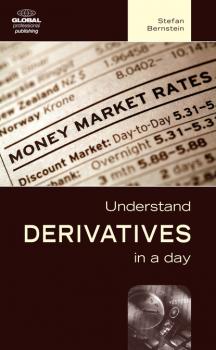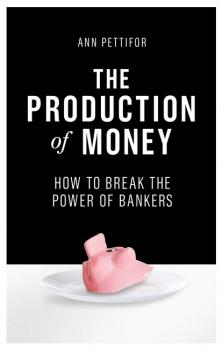Банковское дело
Различные книги в жанре Банковское делоFrom Crisis to Confidence
From Crisis to Confidence not only describes the process which the economy must go through before a full recovery after the financial crash, it also describes the journey that must be travelled by the discipline of economics. As economics students and other commentators question post-war macroeconomics, Roger Koppl provides some of the answers needed to understand the long slump since 2008. A theory of confidence is needed in any economic framework that is to explain one of the most important periods in modern economic history.
Understand Derivatives in a Day
A ‘derivative’ is simply a financial instrument derived from an underlying asset or stock. This book explains in layman’s terms, and with worked examples, of the major derivatives and how they function. Not only will the complete beginner gain an understanding of the various markets and opportunities that exist for trading, but more sophisticated investors should learn enough to consider derivatives for their own account. Even if you choose not to venture into the derivatives market on your own, you will at least be able to judge if investments being made on your behalf are in safe hands. Indeed, anyone with a pension, a mortgage or even a bank account cannot afford to turn a blind eye to derivatives. You will find a great many worked examples of traded options, futures, swaps, caps, collars and currency instruments. Each is presented clearly and avoids the unnecessary complexity, which market sentiment or other intangible factors might bring to the equation – though these factors are nonetheless debated separately for the sake of completeness so as not to obscure the main issues at stake. Once the basics of each financial instrument have been covered, derivative concepts are expanded into specific case studies. These show how private traders and professionals alike could use combinations of individual instruments to achieve a particular effect. Painting the full picture in a such a manner makes it easier to understand what each party’s motives and obligations are, the risk/reward ratio involved in each transaction, and how simple models are constructed to track the progress of an investment. Throughout the book you’ll see just how easily very large amounts of money can be made in the various derivative markets. So, to balance the picture, there is a chapter devoted to the effects of getting derivatives trading wrong, based on certain high profile events over the last few years. Obviously an ‘Understand in a Day’ book can only give you an overview of the subject, and you should seek more in-depth advice before trading derivatives yourself.
Retail Banking 3rd
Since the second edition of Retail Banking the world of banking has continued to go through radical change. The reputation of banks has fallen dramatically and now in many cases bankers are seen as pariahs. Yet with many economies in the western world sluggish, the need for good banking is required more than ever and strangely many of the previous basics of banking are just as relevant today. This text is a user-friendly guide and introduction to the nature of retail banking in the modern financial services industry. The book comprehensively explains how banking works, covering subjects such as payment methods, fund transfers, collecting and paying banks and the principles of the banker-customer relationship. It covers the fundamental aspects of banking and the intermediation plus the need for balance between liquidity and profitability. It introduces the topic of lending, where some key credit risk tools are reviewed and applied, and basic securities, a vital “secondary repayment method” if credit default occurs. The book puts the topical area of retail banking into context for students, readers and bank staff alike.
History of Money
This is a straight-forward, readable account, written with the minimum of jargon, of the central importance of money in the ordinary business of the life of different people throughout the ages from ancient times to the present day. It includes the Barings crisis and the report by the Bank of England on Barings Bank; up-to-date information on the state of Japanese banking and the changes in the financial scene in the US. It also touches on the US housing market and the problem of negative equity. The paradox of why more coins than ever before are required in an increasingly cashless society is clearly explained, as is the role of the Euro coin as the lowest common denominator in Europe's controversial single currency system. The final section provides evidence to suggest that for most of the world's richer countries the era of persistent inflation may well be at an end. This new edition is updated and takes account of important recent developments such as the independence of the Bank of England, the introduction of Euro notes and coins from 1st of January 2002 and developments in electronic money.
The Production of Money
What is money, where does it come from, and who controls it? Money makes the world go round: but what is it really? And how is it produced? Above all, who controls its production, and in whose interests? Money is never a neutral medium of exchange. Nor are bankers simply go-betweens for savers and borrowers. In this accessible, brilliantly argued book, leading political economist Ann Pettifor explains in straightforward terms history’s most misunderstood invention: the money system. Pettifor argues that democracies can reclaim control over money production and subordinate the out-of-control finance sector to the interests of society, and also the ecosystem. She also examines and assesses popular alternative debates on, and innovations in, money: positive money, helicopter money and the rise of goldbugs. She sets out the possibility of linking the money in our pockets (or on our smartphones) to the change we want to see in the world around us.
Goal!
What if you could achieve any goal you wanted, and you knew you would succeed? Would you start a business? Switch careers? Lose weight? Based on the authors' real-world experience coaching the world's top executives, GOAL! presents a proven, step-by-step program for achieving any goal in your career or your life. The book's unique 30-Day Goal Track will keep you motivated and disciplined to move any project forward in just 30 days. Easy-to-follow worksheets guide you from precisely conceiving your goals to taking action to achieve them. Each exercise takes only minutes a day, but following the GOAL! plan will put you on a guaranteed path to realizing even your most ambitious dreams.
The NICE Reboot
Lack of confidence and fear of failure often hold women back from being entrepreneurs. In The NICE Reboot, Penina Rybak provides a self-help manual for today's female entrepreneurs who are looking for practical help, who need to stay current, and who want to be more tech-savvy. Entrepreneurs who are also trying to juggle work, family, personal growth, and satisfaction with their lives.This inspirational as well as practical book is for entrepreneurs who need to learn about current technological trends and how these trends affect marketing, productivity, and their success. Based on her extensive personal experience, Rybak reveals: Practical strategies to increase your business and technology IQs; The imperatives you need to fulfill to orchestrate change and make a difference for future generations; How the iPad can be used to help you forge a path to create innovative services/products.The book is filled with examples and inspiring advice from entrepreneurial thought leaders, hyperlinks to hundreds of helpful articles, and philosophical questions for you to consider. It's a blueprint of best practices to help you become a better female entrepreneur in today's start-up culture.
When Mandates Work
Starting in the 1990s, San Francisco launched a series of bold but relatively unknown public policy experiments to improve wages and benefits for thousands of local workers. Since then, scholars have documented the effects of those policies on compensation, productivity, job creation, and health coverage. Opponents predicted a range of negative impacts, but the evidence tells a decidedly different tale. This book brings together that evidence for the first time, reviews it as a whole, and considers its lessons for local, state, and federal policymakers.
Bankruptcy Laws
A bankruptcy laws study guide helps because it will explain what you need to know before you file. You will be able to determine whether or not you should even file for bankruptcy. If you do not have anything that the creditors can take from you, like a car, you may not need to even file for bankruptcy. On the other hand, if you do have personal property that the creditors can take, this guide will let you know under what circumstances you may be able to keep it with bankruptcy. Also, it will explain bankruptcy laws in your state.
Secured Transactions (Speedy Study Guides)
Secured Transactions are contracts where a bank or other creditor holds rights to an item for security for funds owed. These often come in the form of mortgages, auto loans, boat loans, or business loans where the holding of stock rights is seen as a common market ploy. A guide to explain these types of transactions would benefit the consumer by explaining the whole process, the laws involved, and the benefits to both the customer and the creditor. People are more likely to maintain payments when they understand the full ramifications of default.









